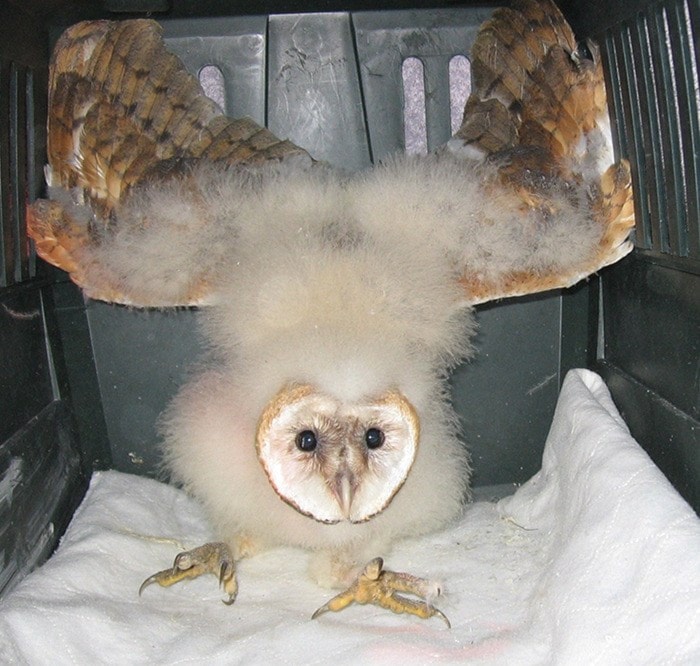Baby bird season is certainly in top gear this year; MARS has been inundated with a bumper crop of babies. Our intensive care nursery has few spaces left but thankfully baby wildlife tends to mature quickly leaving space for new arrivals.
One of the most fascinating and mysterious birds are owls which are also one of my favourites, especially the barn owl. This species of owl is a unique family that has been dated from fossilized remains to be between 12 and 20 million years old.
Barn owls are easily identified by a number of distinct features that are not seen in any other owls. White, heart-shaped faces are outlined in dark brown feathers highlighting their brown almond-shaped eyes. In the centre of the face is a large beak hidden amongst the facial feathers. Barn owls are medium-sized owls and their plumage is a great example of camouflage. Their counter shading is an adaptation used to provide the owls with concealment, blending perfectly into their habitat. Their backs are brown and buff coloured with dark brown speckles and their breasts are white; this allows them to change colour as they appear to 'disappear' when changing direction in flight.
Barn owls are one of the best known owls being distributed worldwide with the exception of Antarctica; in British Columbia they are found in the southern coastal valleys including Vancouver Island.
Until the early 1900's barn owls were not found in southern parts of Canada where they could not survive in sub-zero winter temperatures. With the development of agricultural land and the building of farms, they gradually adapted seeking shelter in barns and abandoned buildings during the winter.
Barn owls are poorly adapted to freezing temperatures; they have long, lightly feathered legs, thin body plumage and scant fat reserves. During cold nights they crouch over, sitting on their legs or standing on one foot, tucking the other into their warm belly feathers. In contrast in the summer heat they have nature's built-in cooling system which provides an increase in blood flow to the least feathered parts of the body, cooling them by evaporation. Birds do not have sweat gland so cannot cool themselves by sweating, and instead they open mouth pant like a dog which cools their body temperature.
Habitat for barn owls is open farm lands with barns but they are also found in old out-buildings and will also shelter in caves, cliffs and even man-made boxes. A few years ago MARS rescued two baby owlets that were found in a chimney. Barn owls' main food source is field mice and other rodents which they can consume in great numbers in one night, they will even store some extra mice for a late night snack.
Farmers welcome barn owls as they control the rodent population in the barns. MARS received two baby barn owls in the last few weeks; both had been found on the ground having either fallen from the nest or orphaned from their mother. Please check our website www.wingtips.org to view a priceless video clip of a baby barn owl at feeding time; you will be treated to the amazing vocalization these owls possess which is why they were often accused of being spooky and ghostlike. In order to prevent birds from moving into your chimney it is recommended that screens are installed, a flock of starlings or swifts can make a huge mess in a few short hours.
Please make sure you drive with care there a lots of fawns on the roads especially in the Comox area. Ditches have been cleared but the fawns still lay low jumping out when least expected. To check our calendar of upcoming events please go to our website, to report inured or orphaned wildlife please call 250-337-2021.
Sandy Fairfield is the educational co-ordinator for the Mountainaire Avian Rescue Society (MARS). The MARS column appears every second Thursday.
